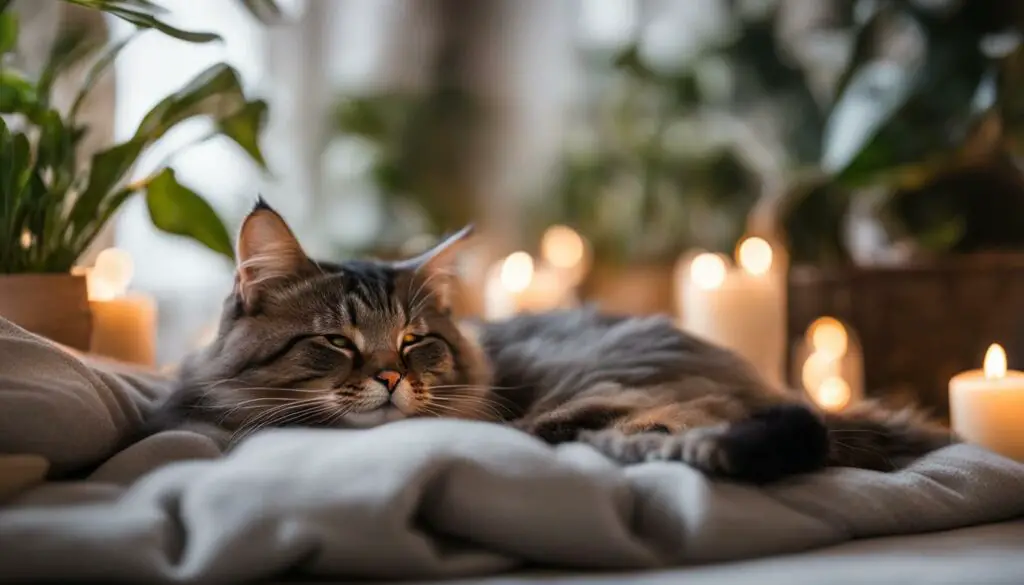I understand how challenging it can be when your cat is causing you stress. Cats, just like humans, can experience anxiety and stress, and it’s important for us as owners to know how to help them. Managing and reducing stress in cats is crucial for their overall well-being, as prolonged stress can lead to physical and behavioral problems. In this article, I will share effective strategies to cope with a stressed cat, providing you with practical tips and insights to create a peaceful and stress-free environment for both you and your feline friend.
Key Takeaways:
- Recognizing the signs of stress in your cat, such as changes in behavior and physical symptoms, is crucial for early identification and effective solutions.
- Cats exhibit both physical and behavioral symptoms when stressed, including changes in appetite, overgrooming, aggression, and hiding behavior.
- Moving to a new home, introducing new pets, and competition for resources in multi-cat households are common sources of stress for cats.
- Strategies for coping with stress include gradual introductions, providing adequate resources, creating safe spaces, and maintaining routines.
- Practical tips such as providing mental and physical stimulation, using pheromone diffusers, and creating a safe space can help calm stressed cats.
Signs of Stress in Cats
Cats can exhibit both physical and behavioral symptoms when they are stressed. It is important for cat owners to be able to recognize these signs in order to address any underlying stressors and provide appropriate support for their feline friends.
Physical Symptoms of Cat Stress
When cats are stressed, they may display various physical symptoms. These can include diarrhea, vomiting, overgrooming leading to bald patches or sores, runny nose and eyes, changes in appetite and weight, lethargy, excessive eating or drinking, poor coat condition, changes in toileting habits, and frequent squatting or painful urination.
Behavioral Symptoms of Cat Stress
Behavioral changes are also common indicators of stress in cats. These can include changes in usual behavior routines, toileting outside the litter tray, spraying urine on furniture, excessive scratching, aggression towards people or other pets, increased meowing or hiding, reluctance to play or go outside, excessive grooming, and repeated pacing accompanied by loud meowing.
By keeping an eye out for these signs, cat owners can take the necessary steps to help alleviate their cats’ stress and improve their overall well-being.
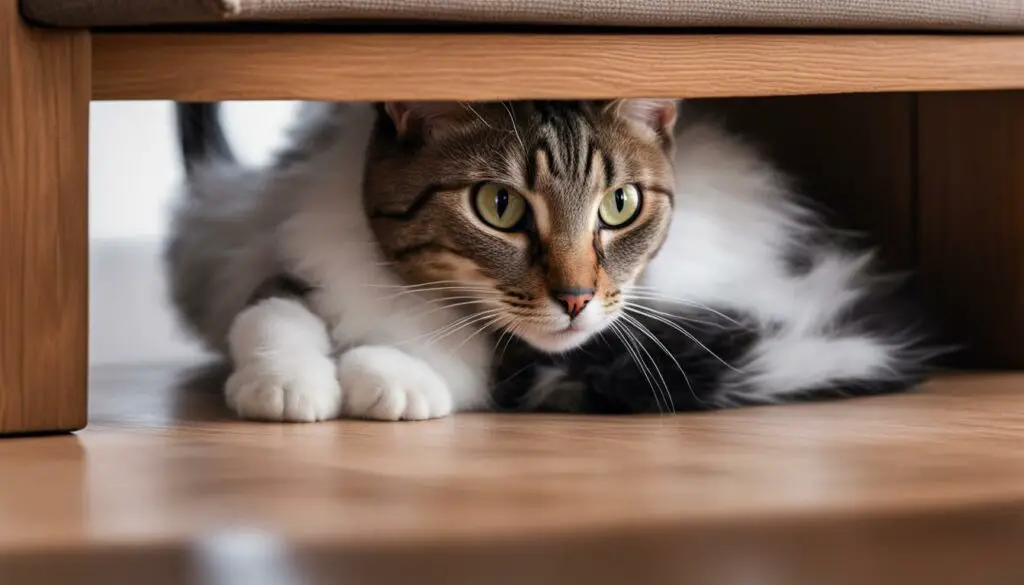
Sources of Cat Stress
There are several common sources of stress for cats that can disrupt their sense of security and well-being. These sources include:
- Moving homes with cats: Relocating to a new environment can be a major stressor for cats. The unfamiliar surroundings and changes in routine can cause them to feel anxious and unsettled.
- Introducing new pets to cats: Bringing a new pet into a household with a resident cat can lead to territorial conflicts and increased stress for both animals.
- Competition for resources in multi-cat households: When multiple cats share the same space, limited resources such as food, water, litter boxes, and resting areas can become a source of tension and stress.
- Unfamiliar cats intruding into the home: The presence of unfamiliar cats in a cat’s territory can trigger territorial aggression and anxiety, leading to stress.
It is important for cat owners to be aware of these potential sources of stress and take proactive steps to mitigate their impact. By addressing these sources of stress, owners can create a more harmonious and stress-free environment for their beloved feline companions.
Table: Common Sources of Cat Stress
| Source | Description |
|---|---|
| Moving homes with cats | Relocating to a new environment can be a major stressor for cats. The unfamiliar surroundings and changes in routine can cause them to feel anxious and unsettled. |
| Introducing new pets to cats | Bringing a new pet into a household with a resident cat can lead to territorial conflicts and increased stress for both animals. |
| Competition for resources in multi-cat households | When multiple cats share the same space, limited resources such as food, water, litter boxes, and resting areas can become a source of tension and stress. |
| Unfamiliar cats intruding into the home | The presence of unfamiliar cats in a cat’s territory can trigger territorial aggression and anxiety, leading to stress. |
Coping with Moving Homes
Moving homes can be a stressful experience for cats, but there are steps you can take to reduce their stress and help them adjust to their new environment. Here are some strategies for coping with moving homes with cats:
- Prepare a familiar environment: Bring your cat’s bedding, toys, and scratching posts to the new home to provide them with a sense of familiarity and comfort.
- Gradual introduction: Allow your cat to explore and adjust to the new environment gradually. Start by confining them to a small area with their essentials, and gradually give them access to the rest of the house.
- Maintain routines: Stick to your cat’s regular feeding, play, and sleep schedules as much as possible. Maintaining familiar routines can help reduce their stress and provide them with a sense of security.
- Provide a safe space: Create a quiet and secure space in the new home where your cat can retreat to when they need some time alone. This can be a separate room with their litter tray, food, water, and a cozy bed.
- Consider temporary arrangements: If the move is particularly disruptive or if your cat is more sensitive to change, it may be best to consider temporary arrangements such as staying with a friend or in a cattery until the move is complete.
By following these strategies, you can help reduce your cat’s stress during a move and facilitate a smoother transition to their new home.
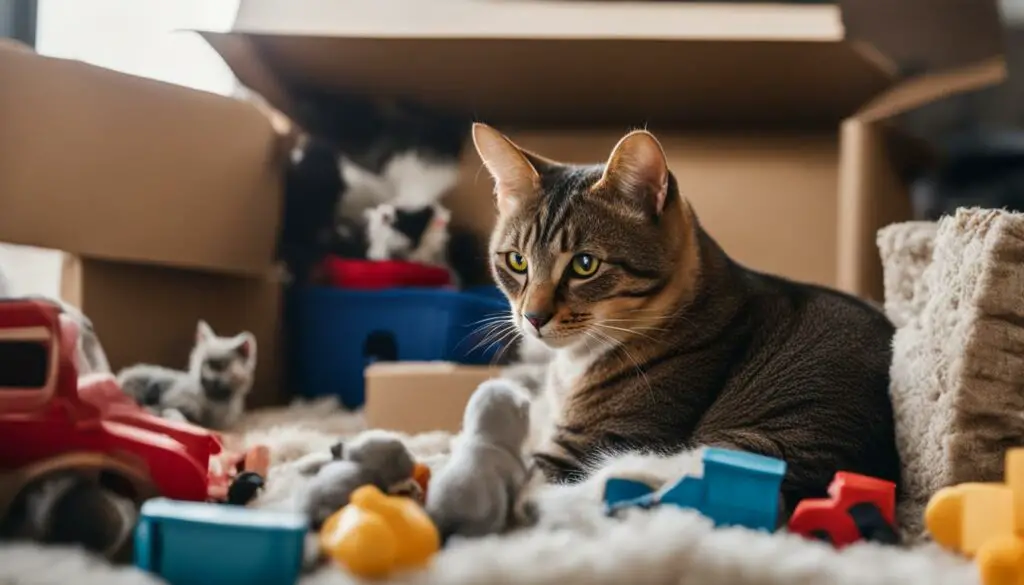
Table: Tips for Coping with Moving Homes
| Tips | Description |
|---|---|
| Prepare a familiar environment | Bring familiar bedding, toys, and scratching posts to provide your cat with a sense of comfort. |
| Gradual introduction | Allow your cat to explore the new environment gradually, starting with a small area and gradually giving them access to the rest of the house. |
| Maintain routines | Stick to your cat’s regular feeding, play, and sleep schedules to provide them with a sense of security. |
| Provide a safe space | Create a quiet and secure space in the new home where your cat can retreat to when they need some time alone. |
| Consider temporary arrangements | If the move is particularly disruptive or if your cat is more sensitive to change, consider temporary arrangements until the move is complete. |
Introducing New Pets to Cats
Introducing new pets to a household with a resident cat can be a delicate process that requires careful consideration. Gradual introductions are key to reducing stress in multi-pet households. By following these steps and maintaining routines, you can help ensure a smooth transition for both your resident cat and the new addition.
1. Separate spaces: Start by providing separate spaces for each cat, including food bowls, litter trays, and resting areas. This will help reduce competition and alleviate any potential stress caused by sharing resources.
2. Scent swapping: Allow the cats to become familiar with each other’s scents before any physical interactions. Exchange bedding or use a towel to rub each cat, then place it in the other cat’s space. This will help them acclimate to each other’s presence without feeling threatened.
3. Controlled introductions: Once the cats are comfortable with each other’s scents, you can proceed with controlled face-to-face introductions. Keep the initial interactions short and supervised, and be prepared to separate them if necessary. Gradually increase the duration of these interactions over time.
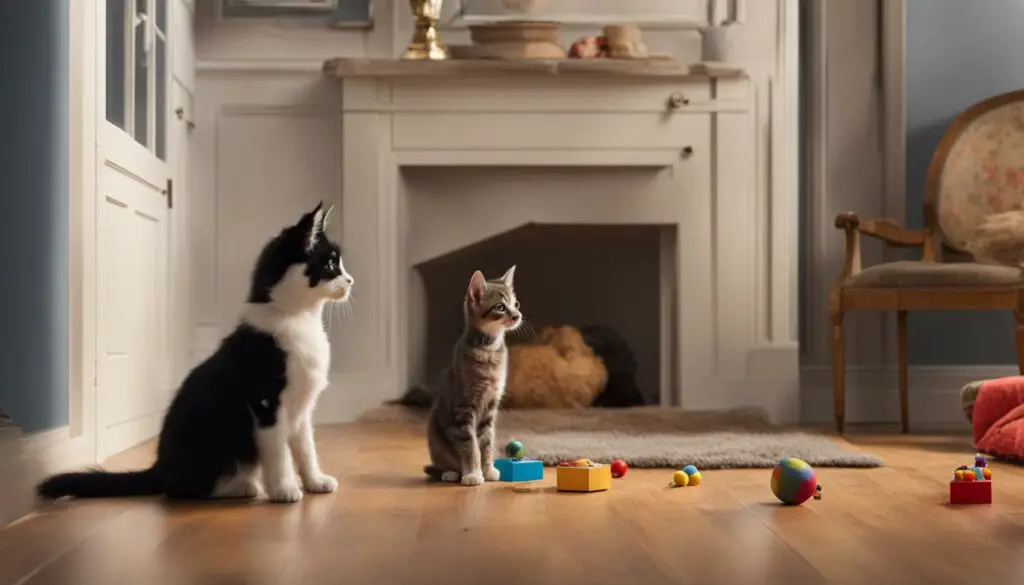
4. Positive reinforcement: Reward both cats with treats, praise, and affection during and after successful interactions. This will help create positive associations and encourage them to view each other in a positive light.
5. Patience and gradual progress: Introducing new pets to cats can take time, so it’s important to be patient and allow them to set their own pace. Don’t force interactions or rush the process. Gradually increase their time together until they can coexist comfortably.
Maintaining routines
Throughout the introduction process, it’s crucial to maintain the resident cat’s routine as much as possible. Cats thrive on stability and familiarity, so sticking to their usual feeding, playtime, and grooming schedules can help reduce stress and provide a sense of security. Keep in mind that any disruptions caused by the new pet’s presence should be minimized to ensure a smooth transition.
By following these gradual introduction techniques and maintaining routines, you can help reduce stress in multi-pet households and promote harmony between your cats. Remember to be patient with the process and provide plenty of love and attention to all your furry companions.
Managing Competition for Resources
Reducing stress in multi-cat households is crucial for maintaining a harmonious environment. One of the key factors in managing this stress is mitigating competition for resources among the cats. By providing adequate resources and implementing proper litter tray placement, you can help alleviate tension and create a more balanced living space for your feline companions.
Providing Adequate Resources
One of the main causes of stress in multi-cat households is the limited availability of essential resources such as food, water, litter trays, and resting areas. To minimize competition, ensure that each cat has their own set of resources. This means providing separate food and water bowls, multiple litter trays, and enough comfortable resting spots for each cat. Adequate resources ensure that each cat can access what they need without feeling threatened or anxious.
Proper Litter Tray Placement
The placement of litter trays is another crucial aspect to consider. Cats are incredibly sensitive to their surroundings, and the location of the litter trays can greatly impact their stress levels. Place litter trays in quiet and accessible areas, away from loud noises or busy foot traffic. Additionally, having multiple litter trays throughout the house can help prevent competition and reduce the likelihood of accidents. Aim for one litter tray per cat, plus an extra one, to ensure that all cats have easy access to this essential resource.
| Resource | Guidelines |
|---|---|
| Food and Water Bowls | Provide separate bowls for each cat to prevent competition. Place them in quiet areas and make sure each cat has easy access. |
| Litter Trays | Have one litter tray per cat, plus an extra one. Place them in quiet and accessible areas away from noise and foot traffic. |
| Resting Areas | Ensure that each cat has their own comfortable resting spots throughout the house. This can include cat beds, blankets, or even elevated perches. |
By providing adequate resources and implementing proper litter tray placement, you can reduce stress and create a more harmonious living environment for your cats. Remember, each cat is unique, so it’s essential to observe their behavior and make adjustments accordingly. Creating a peaceful space where cats can coexist without feeling threatened by resource competition is key to their overall well-being.

Dealing with Unfamiliar Cats Intruding Into the Home
If unfamiliar cats are intruding into your home, it can be a stressful situation for your resident cat. It’s important to take measures to protect your cat’s territory and minimize their stress. One effective strategy is to feed your cat away from the cat flap or entrance where the intruder cats may be entering. By doing this, you create a positive association for your cat with their food, and they will be less likely to feel threatened by the presence of unfamiliar cats.
Another helpful solution is to install a microchip-operated cat flap. This type of cat flap only allows access to cats with a registered microchip, ensuring that only your resident cat can enter the house. This provides an added layer of security and helps prevent intruder cats from entering your home, reducing your cat’s stress levels.
Remember, it’s important to provide a safe space for your resident cat to retreat to when they feel stressed or threatened. This can be a quiet room or area of the house where they can relax and feel secure. Avoid confrontations between your cat and intruder cats, as this can escalate stress levels and potentially lead to aggression.
| Strategy | Description |
|---|---|
| Feed cats away from the cat flap | Helps create a positive association with food and reduces stress |
| Install a microchip-operated cat flap | Allows only your resident cat to enter the house, preventing intruder cats |
| Provide a safe space | Give your cat a quiet room or area to retreat to when they feel stressed |
By implementing these strategies, you can help protect your cat’s territory and create a more peaceful environment for them. Remember to observe your cat’s behavior and consult with a veterinarian or animal behaviorist if their stress levels persist or escalate.

Tips for Helping Cats with Anxiety Issues
Managing cat anxiety is crucial for their overall well-being. Here are some practical tips to help calm stressed cats:
- Create a peaceful environment: Provide enrichment and safe spaces for your cat. This can include providing scratching posts, toys, and cozy hiding spots where they can retreat to when feeling anxious.
- Use food activity toys: Engaging your cat with food activity toys can provide mental and physical stimulation, helping to redirect their focus and alleviate anxiety.
- Consider pheromone diffusers: Pheromone diffusers emit calming scents that can help create a relaxing atmosphere for your cat. These diffusers mimic the natural pheromones that cats produce, which can help reduce stress and anxiety.
Remember to keep your cat’s routine as normal as possible, avoiding sudden changes that can trigger anxiety. Offering positive reinforcement during playtime can also help your cat feel more in control and less anxious. Each cat is unique, so it’s important to understand their individual needs and preferences when implementing these calming techniques.
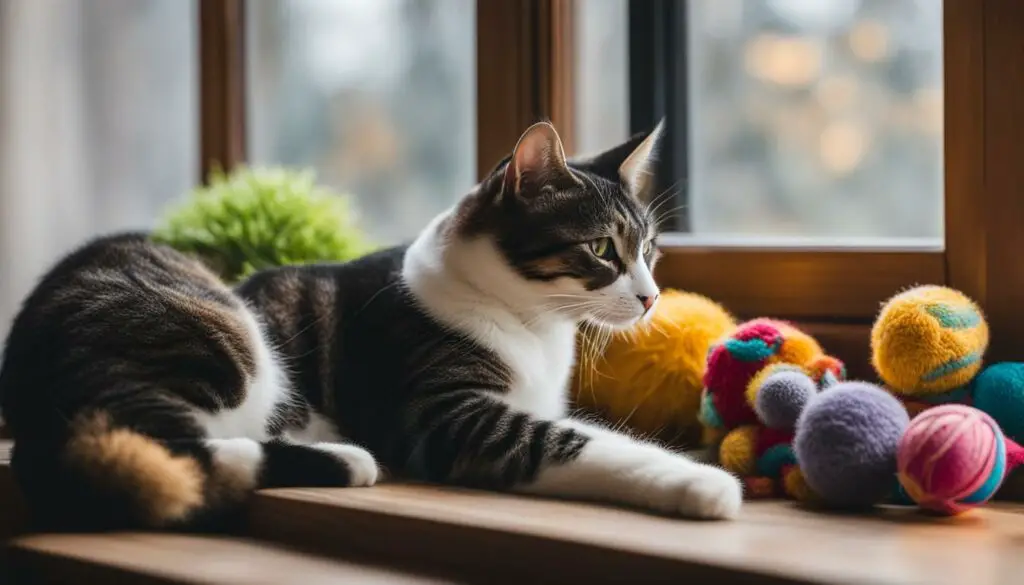
Creating a Safe Space
Creating a safe space for your cat is essential in managing their anxiety. This can be a designated area in your home where they feel secure and comfortable. Provide cozy bedding, a scratching post, and toys in this space. It’s important to respect your cat’s need for alone time and allow them to retreat to their safe space when they need to relax and recharge.
“A calm and stress-free environment is vital for cats to thrive and lead happy lives.”
Food Activity Toys
Food activity toys are a great way to stimulate your cat’s natural hunting instincts and provide mental and physical stimulation. These toys can be filled with treats or dry food, encouraging your cat to work for their meal. Engaging in these activities can help redirect their focus and reduce anxiety.
Pheromone Diffusers
Pheromone diffusers, such as Feliway, can help create a calming environment for your cat. These diffusers release synthetic pheromones that mimic the natural calming pheromones cats produce. The scent can help reduce stress and anxiety, making your cat feel more relaxed in their surroundings.
Coping with Fireworks Season
Fireworks season can be a stressful time for cats due to the loud and unpredictable noises. As a cat owner, it’s important to take steps to help your furry friend cope with the stress and anxiety that fireworks can cause. By implementing a few strategies, you can create a safe and comfortable environment for your cat during this time.
One effective way to help your cat cope with fireworks is by creating a safe space for them to retreat to. This could be a quiet room in your home where they feel secure and comfortable. Make sure to provide their favorite toys, bedding, and a litter tray in this space. Creating a calming atmosphere by playing soft music or using a white noise machine can also help mask the sounds of fireworks.
Another technique that can be helpful is sound therapy. Using specially designed soundtracks or white noise machines that produce calming sounds can help drown out the noise of fireworks and soothe your cat. These sounds can be played in the background to provide a sense of comfort and relaxation.
Remember, during fireworks displays, it’s best to keep your cat indoors to prevent them from running away or getting injured. Close all windows and curtains to minimize noise and flashes of light. If your cat is particularly anxious, consider consulting with your veterinarian who can provide additional advice or recommend appropriate calming products.
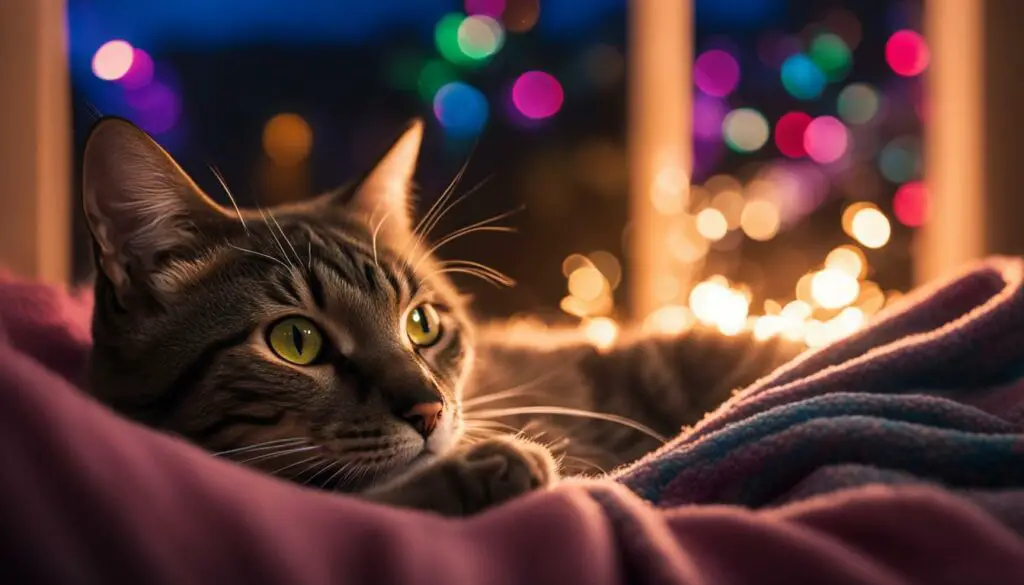
Tips for Coping with Fireworks Season
- Create a safe space for your cat to retreat to during fireworks.
- Provide their favorite toys, bedding, and a litter tray in their safe space.
- Play soft music or use a white noise machine to create a calming atmosphere.
- Consider using sound therapy with specially designed soundtracks or white noise machines.
- Keep your cat indoors during fireworks displays to prevent them from getting scared or injured.
- Consult with your veterinarian for additional advice or calming products if needed.
Recognizing Signs of Stress in Cats
When it comes to our feline friends, it’s crucial to be able to recognize the signs of stress. Cats can’t speak to us directly, so they rely on subtle cues to communicate their emotions. By being observant and attentive, we can identify when our cats are feeling stressed and take the necessary steps to help them.
One common sign of stress in cats is tail twitching. If you notice your cat’s tail twitching rapidly or uncontrollably, it may indicate that they are experiencing anxiety or discomfort. Dilated pupils are another telltale sign. Stressed cats often have larger-than-usual pupils, as their bodies prepare for fight or flight responses.
Hiding behavior is another sign of stress in cats. If your normally sociable cat suddenly starts hiding away or spending more time in secluded areas, it could be a sign that they are feeling stressed. Overgrooming is yet another indication of stress. Cats may excessively groom themselves to self-soothe, resulting in bald patches or sores on their skin.
Understanding these signs and being proactive in addressing them can make a significant difference in your cat’s well-being. By creating a peaceful and stress-free environment, you can help your feline friend lead a happier and healthier life.
The Visual Guide to Recognizing Signs of Stress in Cats
| Signs of Stress | Description |
|---|---|
| Tail Twitching | Rapid or uncontrollable movements of the tail, indicating anxiety or discomfort |
| Dilated Pupils | Larger-than-usual pupils, a physiological response to stress |
| Hiding Behavior | Increased time spent in secluded areas or avoidance of social interactions |
| Overgrooming | Excessive grooming resulting in bald patches or sores on the skin |
Recognizing the signs of stress in your cat is the first step in helping them cope and reduce their anxiety levels. By staying attentive to their behavior and engaging in stress-reducing strategies, you can create a calm and soothing environment that promotes your cat’s overall well-being.
Helping Cats Stay Calm
When it comes to helping our feline friends stay calm, there are a few key strategies that can make a big difference. One important aspect is maintaining a consistent routine. Cats thrive on predictability, so sticking to a regular schedule for feeding, playtime, and quiet time can help them feel secure and reduce stress. For example, feeding them at the same time each day can provide a sense of structure and stability.
Another important factor is avoiding overhandling. While it’s natural to want to shower our cats with affection, some cats may become stressed or anxious if handled too much or in a way that makes them uncomfortable. It’s important to pay attention to their body language and respect their boundaries. If they show signs of stress or try to get away, it’s best to give them space and let them approach for interaction on their terms.
In addition to maintaining routines and avoiding overhandling, providing enrichment and safe spaces is crucial for a calm and contented cat. Enrichment can include providing scratching posts, interactive toys, and puzzle feeders to keep them mentally and physically stimulated. Creating safe spaces, such as cozy hiding spots or elevated perches, allows cats to retreat and relax when they need some alone time or feel overwhelmed.

By implementing these strategies, we can help our cats stay calm and create a harmonious environment for them to thrive. Remember, every cat is unique, so it’s important to observe their individual preferences and adjust our approach accordingly. With patience, understanding, and a focus on their well-being, we can help our furry friends lead happy and stress-free lives.
Practical Tips for Calming Stressed Cats
When it comes to calming stressed cats, there are several practical tips that can make a big difference in their overall well-being. Providing both mental and physical stimulation is key to helping cats relax and feel more at ease. Engaging them with interactive toys, puzzle feeders, and scratching posts can help redirect their anxious energy and promote a sense of calm.
Creating a quiet and safe space for your cat is also crucial in reducing their stress levels. Designate a cozy corner or a separate room where they can retreat to when they need some time alone. Make sure this space is equipped with comfortable bedding, toys, and a litter box to ensure their needs are met.
Offering positive reinforcement during playtime can further enhance the calming effect on stressed cats. Rewarding them with treats or verbal praise when they engage in positive behaviors can help reinforce a sense of security and relaxation. Additionally, regular play sessions not only provide mental and physical stimulation but also help establish a bond between you and your cat, promoting trust and reducing anxiety.

When to Seek Veterinary Advice
As a cat owner, it’s important to pay attention to any persistent anxious behavior displayed by your furry companion. While stress can be a common occurrence for cats, prolonged stress can have negative effects on their physical and mental well-being. If you notice that your cat is consistently exhibiting signs of anxiety, such as excessive hiding, aggression, or changes in appetite, it may be time to seek veterinary advice. Consulting with a veterinarian or an animal behaviorist can provide you with the necessary expertise to identify the root cause of your cat’s stress and develop appropriate solutions.
When seeking veterinary advice for your stressed cat, it’s helpful to provide as much detailed information as possible about their behavior, any recent changes in their environment, or any triggering events that may have occurred. This will enable the veterinarian to make a thorough assessment and determine whether there may be underlying medical conditions contributing to your cat’s stress.
A veterinarian or an animal behaviorist can offer a range of solutions tailored to your cat’s individual needs. This may include behavior modification techniques, environmental changes, or the use of medication if necessary. By seeking professional advice, you can ensure that you are providing the best possible care for your stressed cat and promoting their overall well-being.
| Signs of Persistent Anxiety in Cats | When to Seek Veterinary Advice |
|---|---|
| Excessive hiding or withdrawal | If your cat consistently spends the majority of their time hiding and shows little interest in interacting with their environment or family members. |
| Aggression towards people or other pets | If your cat displays aggressive behavior, such as hissing, biting, or scratching, towards you, other family members, or other pets in the household. |
| Changes in appetite or weight loss | If your cat’s eating habits have significantly changed, either by a loss of appetite or an increase in food intake resulting in weight loss. |
| Excessive grooming or overgrooming | If your cat is constantly grooming themselves to the point of causing bald patches or skin irritation. |
| Marked changes in litter box habits | If your cat consistently avoids using the litter box or exhibits difficulties or pain when urinating or defecating. |
Remember, as a responsible cat owner, it’s crucial to prioritize your cat’s well-being and seek professional guidance when needed. Veterinary advice can provide valuable insights and help you navigate the best course of action to address your cat’s persistent anxiety and stress.
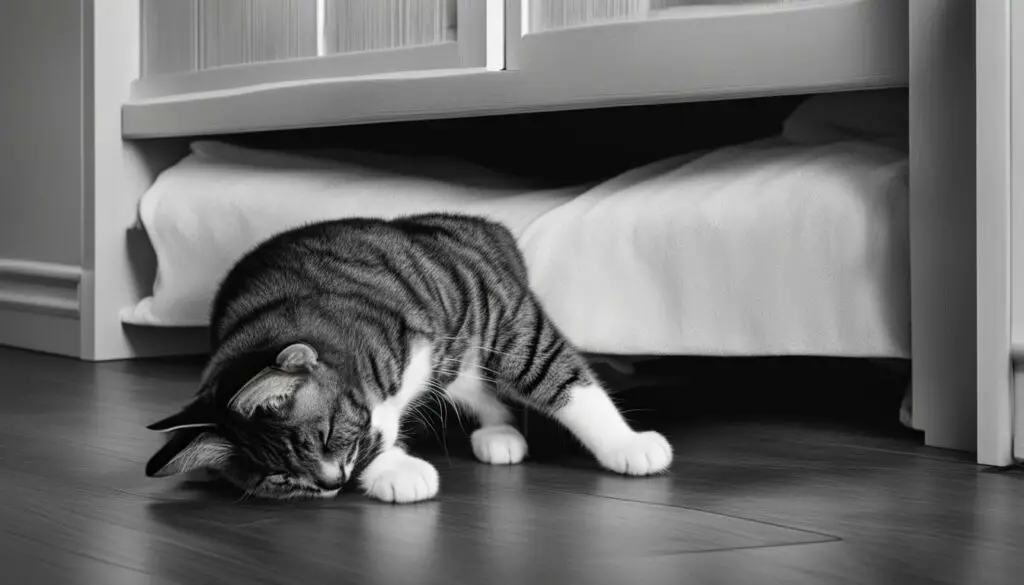
Conclusion
Coping with a stressed cat can be challenging, but by implementing strategies for reducing cat stress and maintaining a peaceful and stress-free environment, you can help your feline friend lead a happier and healthier life.
Recognizing the signs of stress in your cat is the first step. Look for physical symptoms such as overgrooming, changes in appetite, and toileting issues, as well as behavioral signs like aggression, hiding, and excessive meowing. By identifying these signs early, you can address the problem before it escalates.
Common sources of cat stress, such as moving homes, introducing new pets, and resource competition in multi-cat households, should be managed carefully. Gradual introductions, maintaining routines, and providing ample resources and safe spaces can help reduce stress and promote harmony.
Practical tips for calming stressed cats include offering mental and physical stimulation through enrichment activities, ensuring a quiet and safe space for your cat, and providing positive reinforcement during playtime. Remember, each cat is unique, so it’s essential to understand their individual needs and preferences when implementing these strategies.
If your cat’s anxious behavior persists despite your best efforts, don’t hesitate to seek veterinary advice. A veterinarian or animal behaviorist can provide guidance specific to your cat’s needs and rule out any underlying medical conditions that may be contributing to their stress.
By taking proactive steps and prioritizing your cat’s well-being, you can create a calm and stress-free environment that allows your furry companion to thrive.
FAQ
What are the signs of stress in cats?
Cats can exhibit physical symptoms such as diarrhea, vomiting, overgrooming, changes in appetite and weight, and lethargy. Behavioral symptoms include changes in behavior routines, toileting outside the litter tray, aggression, and excessive meowing.
What are common sources of stress for cats?
Cats can become stressed due to moving homes, introducing new pets, competition for resources in multi-cat households, and unfamiliar cats intruding into the home.
How can I help reduce stress during a move?
To reduce stress during a move, provide a familiar environment with their own bedding and toys, gradually introduce them to the new home, and keep their routine as normal as possible. In some cases, it may be best for the cat to stay with a friend or in a cattery temporarily.
What is the best way to introduce new pets to a cat?
It is important to introduce new pets to a resident cat gradually and carefully, allowing them to adapt to each other’s scents and presence without feeling threatened. Maintaining the resident cat’s routine and providing separate resources can help reduce stress.
How can I manage competition for resources in a multi-cat household?
Providing an adequate number of resources such as food bowls, litter trays, and resting areas can help reduce competition and stress. Proper placement of litter trays and separate feeding areas for each cat can also contribute to a more peaceful environment.
What can I do about unfamiliar cats intruding into my home?
Feeding the resident cat away from the cat flap and using a microchip-operated cat flap can help prevent intruder cats from entering the home and reduce the resident cat’s stress. Providing a safe space for the resident cat to retreat to and avoiding confrontations can also minimize stress.
How can I help cats with anxiety issues?
Keeping their routine as normal as possible, providing enrichment such as scratching posts and toys, and creating safe spaces for them to retreat to can help reduce anxiety. Food activity toys and pheromone diffusers can provide mental and physical stimulation and create a calming environment.
How can I help my cat cope with fireworks season?
Creating a safe space for them to retreat to and using sound therapy to mask the noise can be effective in helping cats cope with fireworks. Keeping cats indoors during displays and providing comfort and reassurance can also reduce their stress.
What are the signs of stress in cats that I should look out for?
Signs of stress in cats can include tail twitching, dilated pupils, hiding behavior, and overgrooming. Cats are experts at hiding signs of stress, so it’s important to be observant and proactive in recognizing these signs.
How can I help my cat stay calm?
Maintaining their routine, avoiding excessive handling, and providing enrichment and safe spaces can help cats feel secure and calm. Giving them room to move away and offering positive reinforcement during playtime can also contribute to their overall calmness.
What are some practical tips for calming stressed cats?
Providing mental and physical stimulation through food activity toys, ensuring a quiet and safe space, and offering positive reinforcement during playtime can help calm stressed cats. Each cat is unique, so it’s important to understand their individual needs and preferences when implementing these techniques.
When should I seek veterinary advice for my stressed cat?
If your cat’s anxious behavior persists despite attempts to manage stress, it’s advisable to seek veterinary advice. A veterinarian or animal behaviorist can provide guidance tailored to your cat’s specific needs and assess whether there are any underlying medical conditions contributing to the stress.
How can I create a peaceful and stress-free environment for my cat?
Coping with a stressed cat requires proactive steps to reduce their stress levels. By recognizing the signs of stress, addressing common sources of stress, and implementing practical tips for calming stressed cats, you can help your cat lead a happier and healthier life.

